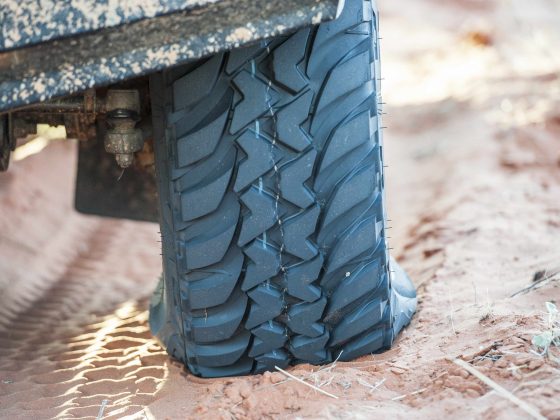The 2018 Mercedes X-Class is coming soon the Australia, but many pundits are already writing it off. “Take a Navara put a star on it and charge 30k more – or just take the Navara?” says Stuart Cameron on Facebook, and many echo his sentiments.
These thoughts aren’t based on nothing, either. At the base of it, the Mercedes X-Class is based on the same platform as the Nissan Navara, which was a joint development with Renault through their alliance. So by nature, the Mercedes X-Class will share plenty with the Navara.

So, let’s run through the similarities and differences.
What’s the same?
Chassis.
The chassis is the majority of the ‘platform’ after all, which sits underneath the Navara and X-Class alike. This is a common sight for most dual-cab utes: steel ladder chassis, which supports an underslung spare, independent front suspension and a live rear axle. Unlike the above image, the X-Class will use the coil-sprung rear end that is employed by dual-cab Navara utes.

Suspension.
The basic suspension layout of the X-Class and the Navara will be the same. There’s an independent front end with upper and lower links, which is ubiquitous across pretty much every 4X4 ute. Where the Navara and X-Class do differentiate to other utes is the coils in the rear end, instead of the commonly-used leaf packs. Nissan’s Navara does ride nicely as a result of the coils, but does have a trouble getting loaded and/or towing up to GVM. Will the X-Class have the same problems, or also suffer from the ridiculous tow ball weight penalty of the Navara? We’ll have to wait and see.
2.3-litre engine & drivetrain
Developed by Renault, used by Nissan, and now nabbed by Mercedes. It comes in two flavours: a single-turbo unit that makes 120kW and 403Nm, used in the low-spec models, or a twin-turbo unit that makes 140kW and 450Nm. The twin-scroll version is the Navara’s bread-and-butter option, giving an impressive blend of refinement, grunt and efficiency.

The 2.3-litre diesel is well managed through a seven-speed automatic gearbox, which uses a part-time 4X4 setup. With these engines, the Mercedes X-Class will also use these gearboxes and 4X4 setups.
What’s different?
The V6:
The X-Class will initially only be available with the Nissan/Renault sourced 2.3-litre diesel, but coming halfway through 2019 is their glanzstück engine, a 3.0 litre V6 diesel, that makes 190kW and 550Nm.
Those engine outputs equal the torque of the Amarok’s V6 diesel, but usurps it with 25 more kilowatts. It’s worth noting that the Amarok V6 does have an overboost function, which increases outputs to 180kW and 580Nm for ten seconds, in certain conditions.

Mercedes have to reinforce the chassis in places to handle the V6, and we can safely assume the suspension tune will be different as well. Along with a Benz engine, the gearbox will be a 7G-TRONIC PLUS unit, a different 7-speed auto to the 2.3-litre gearbox. Like the V6 Amarok, the V6 X-Class will be full-time 4X4.
Suspension tune.
Mercedes will rework the suspension tune to improve and differentiate from the X-Class. We haven’t driven one yet, so cannot tell you how successful or unsuccessful this is. Mercedes will have to colour in between the lines of the basic setup and geometry of the Navara, but plenty can still be done to change the behaviour of the ute.
Wheel track.
This is one that X-Class knockers will need to note. Where the wheelbase stays the same, a noticeably wider wheel track on the X-Class will make for a very different behaving-and-looking 4X4. 1632mm (front) and 1625mm (rear) are listed for the X-Class, a 55-62mm increase over the Navara. This will make the X-Class handle differently, and will also impact the way it drives off-road. What we don’t know yet is how they are doing it. The most simple way would be fitting wheels with a neutral or slightly negative wheel offset, changing the design of the hub, or Mercedes might increase the size of the suspension links, at a much greater expense overall.

Price.
Like, duh. Premium brands attract a premium price tag. X-Class Australian pricing hasn’t been confirmed yet, but you can expect the pricing to be commensurate with the prestige of the brand. Although it’s their first dual-cab ute, it’s not their first 4X4 ute. Mercedes will have to keep things competitive, however. It’s still a 4X4 ute at the end of the day.
interior and exterior.
Quite obviously, these are two points where things are noticeably very different. The X-Class looks like, well, an X-Class instead of a Navara. While some are disappointed that the final product was quite toned-down compared to the concept that originally got tongues wagging, the final product of the X-Class brings it in line with the rest of the German marque’s lineup.

Where the Navara’s interior, especially in the ST-X, is quite a nice place to be, the X-Class does look to take it up another notch. Actual specs and inclusions for Australia haven’t been listed yet, but Mercedes won’t dare come into this segment with a half-cocked interior. Competition is stiffer than ever in this segment, and new brands will always find it hard to carve their share from well-established competitors. Mercedes are keeping the X-Class interior simple and uncluttered, with premium materials and finished dotted around to justify the extra spend (and the badge on the front).













